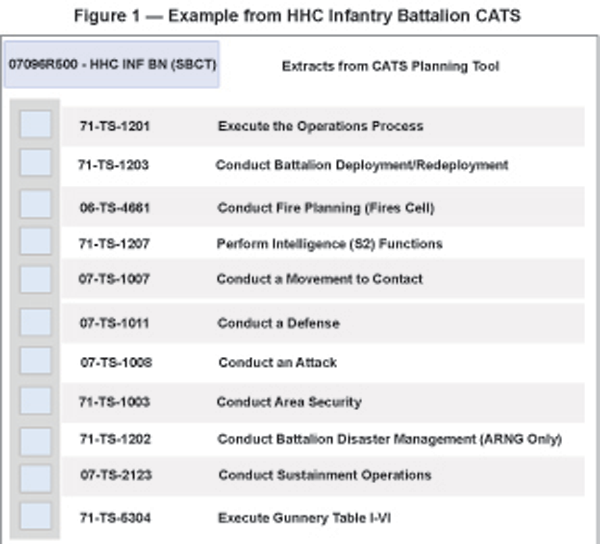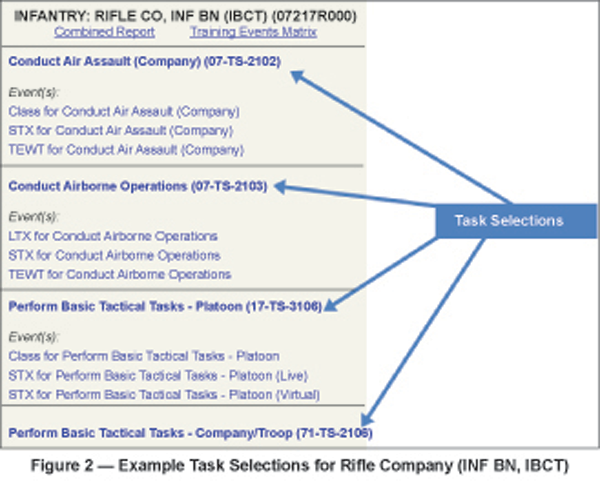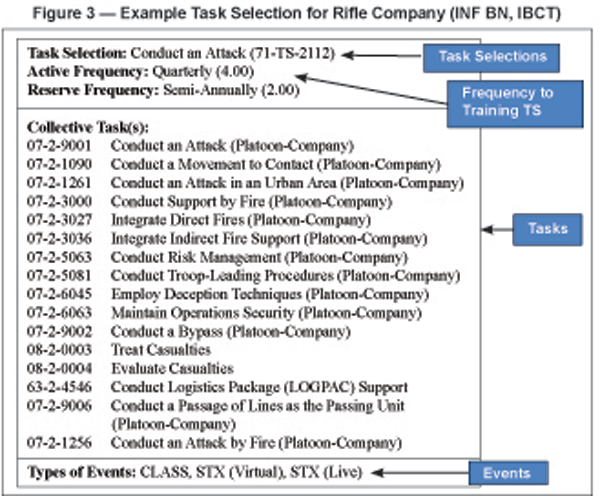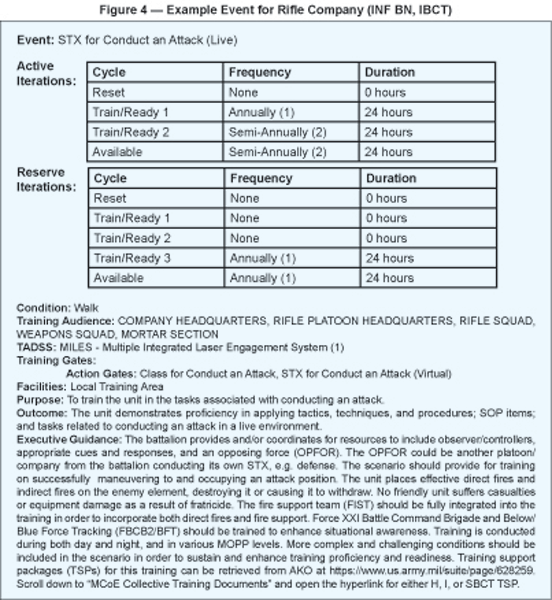CATS provides Training Assistance
by SGM Charles Covington
About a year ago, I reviewed Army Doctrinal Reference Publication (ADRP) 7-0, Training Units and Developing Leaders, and learned about a number of changes. The new doctrine applied the operations process to training management, revised the mission essential task list (METL) concept, and introduced the idea of key collective tasks (KCT). The new training doctrine also included Combined Arms Training Strategies (CATS). CATS provide task-based, event-driven training strategies to assist commanders in planning and executing training events that build and sustain Soldier, leader, and unit proficiency in METL. CATS are part of the Digital Training Management System (DTMS), a web-based tool that helps plan, resource, and manage unit and individual training at all levels. All of these resources are available on the Army Training Network (ATN), a one-stop shop for training products and services — https://atn.army.mil.
Through ATN’s Ask the Trainer feature, I inquired about using the CATS planning tool for METL development. The CATS program team answered all of my questions, and I invited them to the 72nd Infantry Brigade Combat Team’s training center this past January. CATS team analysts provided instruction on the updated training doctrine and automated tools. We provided the analysts with feedback and recommendations on updating the unit CATS. The visit was so valuable that we brought the CATS team back to provide CATS instruction to the entire brigade’s leadership (every officer, command sergeant major (CSM) and operations NCO) as a precursor for METL development at the battalion and company levels. The CATS team’s assistance can help any Infantry unit improve training, develop leaders, and implement Army training doctrine.
The CATS Program is a Department of the Army (DA) program managed by the Combined Arms Center Training (CAC-T) at Fort Leavenworth, Kan. CATS replaced the Army Mission Training Plans (MTPs) in 2007 and are now the primary reference for unit training guidance. CAC-T sends mobile training teams (MTTs) to units to train, educate, and assist Soldiers and leaders on the use of CATS, DTMS, and ATN. These teams also clarify training doctrine in Army Doctrine Publication (ADP) 7-0 and ADRP 7-0. Over the past six months, the CATS MTT has conducted about 20 unit visits and solicited suggestions for improving CATS. The operational Army’s recommendations help the CATS team improve training strategies, which are developed by the Army proponents at the Training and Doctrine Command (TRADOC) centers and schools.
The CATS Program is governed by Army Regulation (AR) 350-1, Army Training and Leader Development. It is implemented by TRADOC Regulation 350-70, Analysis, Design, Development, Implementation, and Evaluation. It also supports AR 220-1, Commanders Unit Status Report. The CATS program consists of three components: the combined arms training strategy, the ATN CATS Viewer to examine training strategies, and the DTMS CATS Planning Tool. It allows unit leaders and trainers to manipulate the baseline unit information within the training strategy to develop a unit specific training plan.
Training Strategy
CATS assist leaders and trainers in developing unit-specific training plans to achieve training readiness. They integrate mission essential tasks (METS) and standards in weapons training (STRAC) consistent with the Army Force Generation (ARFORGEN) model readiness cycle process. CATS are based on the company-level tables of organization and equipment (TOEs). The headquarters and headquarters company (HHC), detachment (HHD), troop (HHT), or battery (HHB) unit CATS capture both the company and higher headquarters’ training requirements (see Figure 1).
There are two types of CATS: unit CATS and function CATS.
Unit CATS: Unit CATS are TOE-based and focus training on the unit’s mission, capabilities, and functions. CATS are composed of task selections that are descriptive of a unit’s missions, capabilities, and/or functions. Task selections are groupings of tasks that can logically be trained together during a training event. Within the construct of a unit CATS and as allowed by ADRP 7-0, the task selections can be used as METS. These task selections are aligned with and support their next higher unit’s METL. Based on the unit’s METL and the higher commander’s guidance, training covers the task selections and the supporting collective tasks most important for mission success and flexibility for new missions.
Function CATS: Function CATS address functional capabilities common to multiple units and echelons, providing a strategy to train for a specific function or mission. Function CATS can be useful when required to perform an out-of-design mission. Function CATS supplement unit CATS and support functions that are not unique to a specific unit type, or they may support training of warfighting functions or missions that support operational themes. Examples of function CATS are counterinsurgency operations and peace enforcement. Function CATS contain the same structure as unit CATS.
CATS Components
CATS reflect TOE-specific generic training strategies in a crawl-walk-run training progression. They are based on collective tasks which are grouped into task selections that reflect the mission, functions, and capabilities identified in the TOE and provide a recommended frequency for training. An Infantry unit can manipulate the training strategy to generate a unit-specific training plan by selecting the appropriate CATS task selections, its associated collective tasks, and the appropriate training event for a variety of missions. The components of CATS are:
Collective Tasks: A collective task is a clearly defined, discrete, and measurable activity or action which requires organized team or unit performance and leads to accomplishment of the task to a defined standard. A collective task describes the performance of a group of Soldiers in the field under actual operational conditions, and contributes directly to mission accomplishment. It may also be a mission requirement that can be broken down into individual tasks (TRADOC Pamphlet 350-70-1).
Unit Task List (UTL): TRADOC proponents perform analysis on the mission, capabilities, and functions of each unit TOE. Proponents identify the collective tasks necessary for the unit to accomplish its mission as well as the unit’s capabilities and functions. The tasks are organized as a UTL for each TOE. A CATS-generated report (in PDF flat-file format) from DTMS or ATN includes the UTL at the end of the CATS report. The UTL for a unit is also found in DTMS in the CATS Planning Tool.
Task Selections: CATS include multiple task selections based on the unit’s mission, capabilities, and functions. In some cases additional task selections are identified to address specific activities and requirements found in doctrine. They are titled to correlate with the TOE mission, functions, or capabilities (see Figure 2).
A task selection is a grouping of collective tasks from the UTL that are logically trained together. Because a collective task can support multiple missions, capabilities, and functions, it could be included in more than one task selection. Each task selection recommends frequency on how many times the task selection and collective tasks should be trained to achieve and sustain task proficiency in accordance with ARFORGEN. Task selection frequencies consider ARFORGEN cycles, turnover, turbulence, and skill decline. For example, if a task selection frequency is six, then it is recommended that the task selection be trained at least bimonthly using any combination of the events.
The task selection, with its associated collective tasks and recommended training event frequency, provides a baseline recommendation for the unit leader and trainer to consider when developing the unit training plan (see Figure 3).
When developing the unit training plan, unit leaders and trainers can modify each task selection by accepting, deleting, or adding collective tasks. They also can change the recommended training frequency of each task selection to meet training objectives and task proficiency. Task selections:
- Provide recommendations on training audience (TOE units and elements), what (collective tasks), and how often (event frequency) to train.
- Provide crawl-walk-run training events that allow the unit to achieve proficiency on the UTL collective tasks and often span multiple task selections.
- Offer more than one event for each task selection.
- Can be a MET at battalion and company levels (per ADRP 7-0).
Training Event: CATS provides a method or means to train the selected collective task(s) for a specific task selection. Each event provides recommendations about the training audience, how to train, and necessary training resources. Each task selection lists multiple events that provide the crawl-walk-run training methodology for collective tasks. Based on the unit leaders and trainers assessment of the collective task proficiency, one or more recommended training events can be included to achieve task proficiency. The events provide options to commanders to accommodate training at the appropriate level of difficulty based on their training readiness assessment.
When developing the unit training plan, the unit leaders and trainers can manipulate event-specific recommendations to meet their objectives. Figure 4 provides an example of information specified for each event.
Event Iteration: This is the number of times the event is recommended to be trained during each ARFORGEN phase. The total recommended iterations for all of the events in the task selection will not exceed the task selection frequency. Iterations for training for Regular Army (AA) and Reserve Component (RC) units will be different because the units have different ARFORGEN training requirements and do not have the same number of annual training days.
Event Duration: This is the recommended duration of the event, in hours, and includes time to execute the training, to conduct after action reviews, and to retrain if necessary. The duration of the events is designed to fall short of the number of training days available to the AA or RC force as specified in the ARFORGEN training templates. To confirm the training day calculation, you should avoid double-counting an event if it is recommended for multi-echelon training.
Training Audience: These are the units, elements, or individuals in the unit TOE recommended to participate in the event to achieve the commander’s desired end state and level of proficiency. An entire unit or certain individuals can be specified. Where units or individuals not contained in a unit’s TOE should participate, the applicable TOEs are included.
Multi-echelon Training: Multi-echelon training is the simultaneous training of a unit’s subordinate elements under the umbrella of a higher-echelon event. For example, while the battalion staff participates in a brigade command post exercise (CPX), the battalion HHC and other subordinate companies could concurrently conduct situational training exercises (STXs) or live-fire exercises (LFXs). The multi-echelon training listed with each event lists other CATS task selection events from subordinate elements, staff sections, or other units that may be included.
Facilities: Facilities recommended for the event include ranges, classrooms, maneuver area requirements, and other Army training support system (TSS) requirements not addressed in the training aids, devices, simulations, and simulator (TADSS) section.
Training Gates: These are recommended events and task selections the unit should be proficient in prior to training the event. The identification of training gates provides a method to achieve a level of task proficiency before training the next higher level event to:
- Avoid serious personal injury or equipment damage.
- Ensure the training audience will be sufficiently qualified and trained to benefit from participation in the current event.
- Ensure the training audience will be proficient enough to not hinder training for other participants.
Generally, there are four types of training gates: collective task gates, action gates, drill gates, and individual tasks.
Warfighter Training Support Packages (WTSPs): A WTSP is a complete, detailed, exportable package integrating training products, materials, and information necessary to support operating force training. WTSPs provide the details for securing the training materials, venues, and other necessary resources identified in each unit task selection event supporting the DA-approved METLs for designated units. If a WTSP is applicable to an event, it is listed.
Resources: This identifies resources projected to be used during the event. Data is based on the TOE equipment of the training audience.
The DTMS CATS Planning Tool: The CATS Planning Tool is a database program that allows unit leaders and trainers to manipulate the baseline unit information within the training strategy to develop a unit-specific training plan. The CATS Planning Tool is the preferred resource to develop a unit training plan because it is integrated with DTMS. Users can use a number of functions within the CATS Planning Tool to view, select, assess, and schedule holistic, doctrinal, or unit-selected METL-focused tasks and training events. To access the CATS Planning Tool, the user must have a DTMS account with the appropriate permissions. The steps to access the CATS Planning Tool:
Step 1: From DTMS main menu, select “Planning” then “CATS” to access the DTMS CATS Planning Tool.
Step 2: The DTMS CATS Planning Tool will load the unit CATS by default or can be “switched” to a different CATS using the “Switch CATS” feature.
Some of the major functions that the DTMS CATS Planning Tool provides are:
(1) The METL tab. It is comprised of two windows: Key Collective Tasks and CATS Doctrinal METL. The Key Collective Tasks window facilitates unit selection of collective tasks and task selections to support training to proficiency on each MET in the unit’s METL. The CATS Doctrinal METL window shows the proponent-defined METL-focused collective tasks and task selections.
(2) The Training Events Matrix. It depicts the holistic, unit-selected or proponent defined METL-focused training strategy. It shows the relationship between the task selection and its associated training events, to include recommended frequencies and duration. The strategies are aligned to the ARFORGEN cycle and are differentiated by component.
(3) The CATS Wizard. It provides a step-by-step process for viewing, assessing, selecting and scheduling collective tasks, task selections and training events. It incorporates them into a planning calendar
(4) The Doctrinal Calendar. It facilitates unit planning by importing CATS training events in the unit planning calendar.
The ATN CATS Viewer: The ATN CATS Viewer provides users access to the CATS task data without the requirement for DTMS privileges. To access the ATN CATS Viewer, follow the step-by-step instructions below:
Step 1: Go to the ATN page; under the Unit Training Management Enabler tab, select Combined Arms Training Strategies.
Step 2: Access search CATS.
Step 3: Search by TOE, title, or by proponent.
Step 4: Select unit CATS to view.
Step 5: View unit CATS.
Step 6: To view CATS task selections and tasks, click on the blue hyperlink CATS task selection. A separate window will appear with associated tasks.
Collective task data provide a hyperlink to the training and evaluation outline (T&EO) for each task. The T&EO also captures supporting collective and individual tasks and its references
Step 7: To view and/or download the complete unit CATS, select “Combined Report.”
Conclusion
During the last few years, the Army’s operational tempo has been so high that Soldiers received top-down, prescribed training to support theater requirements. Army leaders are now regaining their skills in unit training management. While they know the unit training management process since it mirrors the operational process, they must now learn the training support capabilities available to them at home station. The CATS team helped educate and refocus my unit on how to plan and conduct training requirements using doctrine and doctrine-based tools. My advice to other units facing similar challenges: Visit ATN and DTMS for your training information and requirements and use CATS. CATS will save you time by providing proponent-approved strategies that will allow you to extract a customized unit training plan to prepare your unit for its next mission. And if you’d like a little more help, then use the “Ask the Trainer” feature to get the support and assistance you need.
CATS Internet Resources
The ATN CATS Viewer website: https://atn.army.mil/dsp_CATSviewer01.aspx#
The DTMS CATS website: https://dtms.army.mil/DTMS/myWorkspace.aspx
The CATS Knowledge Base website: https://atn.army.mil/dsp_template.aspx?dpID=336
CATS Reference Sources
AR 350-1, Army Training and Leader Development (4 August 2011)
AR 220-1, Army Unit Status Reporting and Force Registration – Consolidated Policies (15 April 2010)
The Army Training Strategy (4 April 2011)
ADP 7-0, Training Units and Developing Leaders (23 August 2012)
ADPR 7-0, Training Units and Developing Leaders (23 August 2012)
TR 350-70, Systems Approach to Training Development, Management, Processes and Products (6 December 2011)
P 350-70-1, Training Development in Support of the Operational Domain (24 February 2012)
Army Training Network (ATN) – https://atn.army.mil
SGM Charles Covington is currently serving as the operations sergeant major for the 72nd Infantry Brigade Combat Team, Texas Army National Guard in Houston. His previous assignments include serving as operations SGM for the 1st Battalion, 141st Infantry Regiment in San Antonio and as operations sergeant for the 72nd Brigade’s Special Troops Battalion in Huntsville, Texas.

 Share on Facebook
Share on Facebook email
email print
print


